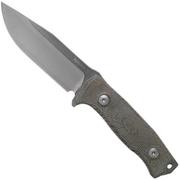

You have an outdated webbrowser. The website might not work correctly.
Survival knives are very sturdy and reliable knives. Survival knives belong to the toughest category of outdoor knives. These knives are designed to help people in emergency situations. Survival knives can be used in extreme circumstances. Think of setting traps, building a shelter, chopping wood, etc. In short, these knives have to be tough. Not all survival knives are very large, though, because survival knives must also be manageable and easy to transport. At Knivesandtools, we have a huge selection of survival knives, ensuring you will always find the one that suits you best.
The first choice to make is the type of steel you're looking for. Do you prefer a blade that is easy to sharpen? One that is stainless? Or rather one made from really tough (but not stainless) carbon steel? Carbon steel, in general, doesn't retain its sharpness as long as stainless steel. However, carbon steel is easy to sharpen, so that shouldn't be a problem. It's incredibly tough and can handle its own. Then there are hybrid steels like D2, which is relatively corrosion resistant but still very tough.
In short; it depends on your intended use and personal preferences.
The handle should be comfortable to hold and offer enough grip in a variety of circumstances. G10 is a commonly used handle material; it's strong and lightweight. Micarta is strong and lightweight too. It differs from G10 in the way it becomes even more grippy when wet. Rubber is by far the best material in wet conditions. The disadvantage of rubber is that it's not very heat-resistant.
Natural materials like horn or wood are stunning, but less suited for survival knives as they're not equipped to handle extreme changes in weather.
The most commonly used blade shape is the drop-point shape. A survival knife with drop-point blade is a true all-rounder, from processing game to building a shelter; it can handle it all. The clip-point blade shape is another popular option, which you might recognise from bowie knives. This shape is optimised for processing game. The spear-point and tanto blade shapes are great piercers. The spear-point is more suitable for general cutting tasks than the tanto.
Survival knives come in many shapes and sizes. There are survival knives with blades of only 10 cm in length, to miniature swords. Which outdoor knife should I choose? A smaller outdoor knife will be perfect for more precise cutting tasks like woodcarving or making feathersticks. Moreover, smaller survival knives are usually easier to carry. Large survival knives, on the other hand, are great for heavy-duty tasks like batoning or chopping away vegetation as you move through the woods.
Survival knives can have a serrated edge, a plain edge or a partially serrated edge. A serrated edge is ideal for cutting through tough materials like rope. Think, for example, of knives designed for pilots, capable of cutting through seat belts or even the relatively thin metal of a cockpit. Serrated blades usually retain their sharpness longer than a plain-edged blade. They are also more suitable to use as an impromptu saw, for example.
Sheaths for survival knives are often made of plastic, kydex, nylon or leather. Plastic sheaths are a usually included with more affordable survival knives. It's water-resistant and easy to clean. Kydex is a great material that is low-maintenance, water-resistant and durable. Nylon is lightweight, resistant to different climates but not very wear resistant. Leather is a stunning natural material, of course, but it's susceptible to wet or too dry conditions. That's why leather will require a bit more maintenance than other materials.
Sheaths can also be used in combination with different carrying systems, like belt clips, belt loops, a leg strap or MOLLE system.